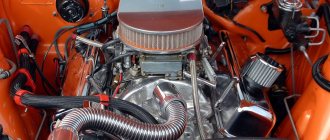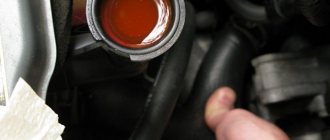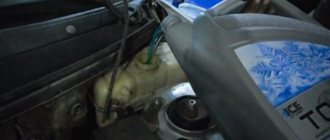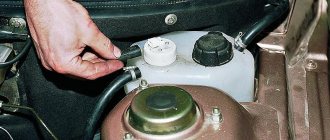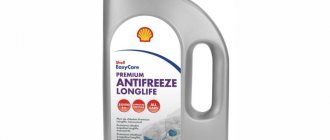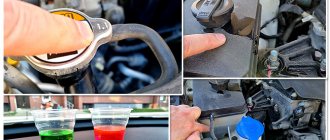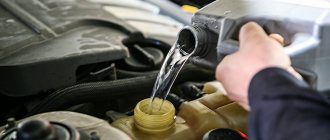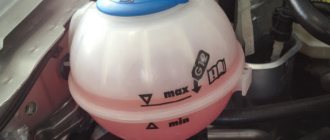Why does antifreeze go away?
One of the common problems that arise with the engine cooling system is a fluid leak. Due to low levels of antifreeze, problems may occur with both the engine itself and parts of the cooling system. Therefore, the fluid level in the expansion tank must be regularly monitored and not allowed to drop below MIN. You can determine that antifreeze is running out by the following signs:
- The coolant level is constantly decreasing;
- the heater stops working;
- The engine temperature becomes higher than normal.
A minimal increase or decrease in the coolant level in the expansion tank is considered normal. However, if antifreeze needs to be topped up periodically, then you need to deal with the problem that has arisen.
A change in coolant level from minimum to maximum is normal.
Engine radiator leaking
The most common reason why coolant leaves the system is damage to the main radiator of the cooling system. The malfunction can be diagnosed by smudges on the unit body or a puddle under the car after parking. Damage to the heat exchanger can be caused by the following factors:
- exposure to corrosion as a result of long-term use;
- hit by a stone flying out from under the wheels.
A leak in the radiator is possible both through the honeycombs and through the tanks
The design of the radiator consists of many honeycombs through which coolant circulates. Even the slightest damage to one of them will lead to leakage. To diagnose a breakdown, you will need to remove the heat exchanger from the car, assess the nature of the damage and try to restore the seal by soldering or argon welding. If you do not take any action to eliminate the leak, the engine will overheat, which sooner or later will lead to serious consequences and expensive repairs.
You can try to restore the cooling radiator by soldering or welding
Malfunction of the radiator or heater tap
Sometimes there is a leak in the interior heater core. The problem manifests itself as a puddle of coolant under the front passenger's carpet, as well as a foggy windshield. In this case, the radiator will have to be removed from the car to identify the damaged area and carry out similar measures as with the main radiator.
The heater radiator, by analogy with the main radiator, can be damaged as a result of corrosion
Depending on the make and model of the vehicle, removing the heat exchanger may require disassembling the instrument panel.
If the leak is caused by a leak in the faucet, drops of antifreeze will be visible on it. The device, as a rule, cannot be repaired and must be replaced with a new part. Sometimes antifreeze begins to leak due to aging of the gaskets between the faucet and the radiator. In this case, they are simply replaced with new ones.
The heater valve also sometimes leaks and needs to be replaced.
Defects in hoses, pipes and pipes
A large number of pipes made of rubber are used as connecting elements in the engine cooling system. Due to constant exposure to an aggressive environment, temperature changes and vibrations, rubber becomes unusable over time and cracks appear. The formation of damage to the pipes clearly leads to a leak of antifreeze as the engine warms up and the pressure in the system increases. Worn hoses must only be replaced. Any tricks and attempts to patch and restore their integrity will lead to leakage and loss of antifreeze. If the malfunction can be eliminated, it will only be for a short time.
Due to the aging of rubber, the pipes begin to leak
The tightness can be compromised not only by damage or wear of rubber pipes, but also by metal tubes, which are also present in the cooling system. These elements corrode and burst over time. Therefore, if a leak is detected, the tubes must be replaced.
Pump failure
Sometimes the reason for coolant leakage is wear of the water pump seals: gasket and oil seal. The gasket most often fails due to long life or as a result of damage, for example, if the pump was over-tightened. Confirmation of pump leakage is a wet engine where the pump is installed, as well as the presence of drops of coolant on the mechanism housing from below. If the malfunction is caused by wear of the gasket, then it is enough to replace it or use a sealant gasket. If the oil seal fails, repairs will have to be made if the pump design allows this. Otherwise, the unit must be replaced.
Over time, the pump begins to leak, which is associated with damage to the oil seal or gasket.
Thermostat
As a result of prolonged use, the thermostat housing begins to leak over time. This unit is responsible for regulating the flow of coolant by opening and closing a valve located inside. In case of any breakdown, the device must only be replaced.
Expansion tank defects
The expansion tank body is usually made of plastic. Over time, it can either burst or rub against body elements, which depends on the installation location. Such a malfunction cannot be ignored, since the container or its lower part will be wet. If the tank is damaged, you can try to solder it, but it is better to replace it with a new one, since soldering will only temporarily eliminate the leak. In addition to the tank, the lid may fail, since a valve is mounted inside it, designed to maintain a certain pressure in the system. If there is a problem with the valve, antifreeze will splash out after the engine warms up. In this case, the cover needs to be diagnosed or replaced.
Cracks sometimes appear on the expansion tank, which cause antifreeze leakage
Cleaning and temporary system repairs
In some cases, the cause of an antifreeze leak may not be damage or excessive wear of individual parts and components. Sometimes the coolant begins to decrease after cleaning the internal surfaces of the equipment with various special means. Performing their direct function, such products remove dirt, scale and rust, which can heal small cracks in the elements of the cooling system. If this happens, a temporary solution to the problem may be the use of additives that are added to antifreeze to eliminate leaks.
How to find an antifreeze leak
Since coolant can leak from different places in the system, you need to know where and how to look for the problem area.
Visual inspection of pipes and clamps
By visual inspection, you can identify areas of coolant leaks. The more it leaks, the easier it is to find the leak. The procedure should begin with the pipes, since on many cars they have free access. During the inspection, you need to carefully check each hose of the cooling system, especially if the elements have been changed a long time ago.
The pipes are checked by visual inspection
In hard-to-reach places, you can use a mirror to check. Damaged hoses must be replaced. If no leaks are found on them, they are still worth inspecting for preventive purposes. Additionally, the clamps are subjected to visual inspection. Sometimes it happens that a coolant leak is caused by a loose fastener. In this case, tightening the clamps more tightly allows you to get rid of the problem in question.
Video: antifreeze leak due to loose clamps
Using cardboard
Using a sheet of cardboard or paper, even minimal leakage can be detected. To do this, you need to place a sheet of paper under the engine compartment. After a long period of parking, drops or a puddle of antifreeze will be clearly visible on the material. Based on the identified location, you can begin to search for the area with the malfunction, which will be much easier to do.
You can often find a leak by looking at a puddle under the car or using cardboard if the leak is minor.
Checking the expansion tank
Diagnosis of the expansion tank can be done in several ways:
- Wipe the body dry. After this, warm up the engine to operating temperature and see if there are any antifreeze leaks on the body.
- The container is dismantled, the coolant is drained and checked using a car pump and pressure gauge. To do this, create a pressure of about 1 atmosphere and monitor whether it will decrease or not.
You can check the expansion tank using a pump with a pressure gauge - The pump creates pressure in the cooling system without removing the tank. This way, there is a chance that the leak can be detected faster.
Using the third method, you can diagnose the entire cooling system for leaks.
When pressure is applied to the system, leaks can be identified
Cover diagnostics
The cover valve can be checked in a fairly simple way. To do this, on a cold engine, unscrew the plug and shake it near the ear. If you can hear the inner ball clicking in the valve, then the device is working properly. If there is no such sound, you can try to wash the lid. If this does not help, then it is better to replace it.
Video: checking the expansion tank cap
Using a fluorescent additive in antifreeze
A rather original way to diagnose a cooling system is to use a special additive in the coolant. Today, such products are presented in a large assortment. As a rule, they are added to antifreeze, and the test is performed with an ultraviolet lamp on a running engine.
One of the effective ways to find coolant leaks is diagnostics using an ultraviolet lamp.
With its help, the location of the leak is identified, one by one checking the elements and mechanisms of the system. This method of checking is one of the most effective, since it allows you to identify hidden leaks, as well as when the coolant leaves in minimal quantities. It is quite difficult to find such places during a visual inspection.
Video: checking the system with an ultraviolet lamp
Consequences of a coolant leak
If a car shows a problem when it throws out antifreeze, then driving it becomes quite dangerous. Negligence, in this case, can lead to both serious breakdowns and irreparable damage, fraught even with the health of passengers and the driver. A few of the most common consequences:
- If the trip does not last long, the pump in the car may become deformed. Repairing it will not be the most pleasant experience. But radical actions can be avoided.
- If this situation is allowed to occur, the engine components will be so damaged that a major overhaul will have to be undertaken.
- The most difficult situation is an engine explosion. Yes, such cases sometimes happen in the practice of people who neglect coolant leakage.
An engine explosion is a factor that can cause irreparable damage to all people who were currently inside the car.
Antifreeze leak without visible smudges
If the coolant leaves for no apparent reason, then most likely the fault is hidden, with antifreeze getting inside the engine.
Cylinder head gasket burnout
The most likely cause of the leak is a blown head gasket or a broken seal between the cylinder head and the block due to engine overheating.
The purpose of the gasket is to seal and separate the engine head from the block.
If the gasket is damaged, antifreeze enters the oil or combustion chamber
Antifreeze entering the cylinders may be accompanied by white smoke from the exhaust pipe, which is the result of coolant combustion. If the gasket is installed incorrectly or burns out, air bubbles can sometimes be observed in the expansion tank. It is impossible to operate a car with such a malfunction, since there is a high probability of damage to the head with subsequent expensive repairs. The malfunction is eliminated by replacing the seal on your own or at a car service center.
White exhaust indicates antifreeze has entered the combustion chamber of the engine.
If the reason lies in damage to the head, the assembly must be checked and ground on a special machine. Some car enthusiasts do the grinding on their own, but since the cylinder head is a responsible mechanism, this procedure is best carried out using specialized equipment in a service setting.
Replacing the gasket
Replacing a gasket may seem like a complicated process, but anyone can do it if they want. The event involves performing the following steps:
- Buy a cylinder head gasket for your car's engine.
- Dismantle the valve cover, air filter and various tubes that are fixed to it.
- Unscrew the cylinder head fastening, for which you will need a head of the appropriate size and a wrench, since the fasteners are screwed in with great effort. You can try to fix the leak by tightening the bolts more. If this does not help, the head will still have to be removed.
- Dismantle the head and gasket.
- They wipe the surfaces on the block and cylinder head, then install the gasket and mount everything in the reverse order. The head is tightened in a checkerboard pattern with the force specified in the repair instructions for your car.
Regardless of the reason for which the cylinder head is removed, a new gasket is always installed.
Video: replacing the cylinder head gasket using the example of a Lanos
Cracked cylinder head or block
In addition to gasket burnout, a leak can be caused by cracks in the head or the block itself, and the coolant does not necessarily have to come out. If such damage affects the oil channels and cooling channels, antifreeze can enter the engine cylinders, followed by mixing the lubricant with antifreeze. In this case, the liquid level decreases and the oil loses its properties. With such a malfunction, severe wear of the power unit parts occurs, jamming and failure.
If a crack forms in the cylinder head or block, antifreeze can escape in large volumes
Since an emulsion is formed when coolant gets into the oil, it is necessary to check the lubricant level and visually assess its quality. If it was found on the dipstick that the lubricant level has noticeably increased and there is a substance in the form of brownish-white foam on it, then this will indicate antifreeze leakage into the lubrication system. During diagnostics, you can also remove the spark plugs. If white spots are found on them, this will also confirm that coolant has entered the oil. In this case, disassembly of the engine and detailed diagnostics of the head and block for cracks will be required. As a rule, this procedure is carried out in a service center.
Various malfunctions can occur with the engine cooling system, as a result of which the antifreeze level decreases, which leads to overheating of the power unit. There can be many reasons for a leak, but almost every one of them can be identified on your own without the use of specialized equipment.
You may also be interested
Why does antifreeze “leave” from the expansion tank?
The situation when the antifreeze has left the tank, and the reasons for this are unclear, occurs even too often - and it sometimes takes a long time to determine why this happened. However, there is a list of typical faults for which the car should be checked first.
Antifreeze goes into the engine: signs and causes
If antifreeze leaks into the engine, then this is a serious problem that requires a solution as quickly as possible. Therefore, every motorist should be able to recognize its signs, know precautions and remedies.
Troubleshooting
The extent of repair work will depend on the nature of the problem. As a rule, if you notice a problem in the early stages, you can deal with the breakdown yourself.
This is interesting: Two simple ways to replace power steering fluid for all cars
But otherwise, when the problem was discovered a long time ago and nothing was done to fix it, you need to contact a service station or a car repairman.
During the cold season. Such breakdowns in the winter are a very common occurrence, especially for older cars. The reason for this is a decrease in the volume of antifreeze under the influence of low temperatures. Subsequently, it becomes necessary to constantly add it to the expansion tank. This situation indicates that everything is in order with the cooling system. This only confirms the usual reaction of antifreeze in cold weather.
Sometimes drivers dilute antifreeze with water. But such actions are not always justified. This can lead to serious consequences, such as engine failure. Today, there are two types of antifreeze in car stores - ready-to-use and concentrated. Only concentrated substances can be diluted with water.
By adding distilled water to a ready-made liquid, you can significantly disrupt its beneficial properties, which will lead directly to failure. Therefore, before diluting antifreeze with water, you need to study the instructions from the manufacturer.
Violation of the tightness of the expansion tank
If antifreeze leaks, there may be different reasons. Depressurization of the tank is one of them. If the structure of the tank is damaged, then the corresponding antifreeze stains will not be visible on it. This happens due to the evaporation of working fluid from the tank due to its depressurization.
Therefore, if a leak of coolant in large volumes is detected, it is necessary to conduct a visual inspection of the expansion tank for mechanical damage. It is quite difficult to restore the tank yourself, so it is better to replace it immediately.
Expansion tank
If the expansion tank body and/or the caps with the gasket on it are old, then there is a high probability that they have microcracks. Another option is to skip the safety valve on said lid. The simplest thing in this case is to replace the cover and install a new gasket. More difficult is to replace the entire tank (including the lid).
Damage to conductors
In this case, coolant stains will be visible. Finding an antifreeze leak when the conductors are damaged is not difficult. Working fluid can leak not only when the car is running, but also when the engine is turned off.
If characteristic stains from antifreeze are observed the next morning, it is necessary to inspect all connections and components. But before starting work, you need to turn off the engine and wait until the temperature in the system normalizes.
During repair work, it is necessary to check all connections for mechanical damage. They can occur in any part of the system or hose. If certain parts are not visible due to poor access, a mirror can be used. When a certain hose is already very old and completely cracked, the leak can only be removed by completely replacing it. Diagnosis is best done in good lighting.
The cause of the leak may be poorly clamped clamps, as well as dried out rubber seals. In this case, antifreeze leaks from the pipes can be eliminated by replacing the seals and clamps. Timely repairs and diagnostics will help avoid big problems if antifreeze is leaking.
Hot
If the leak appears only on a hot engine, the reasons will be completely different. Most often you can find one of these problems:
- Damage to the rubber hose. While the fluid is cold, it does not leak, but when it heats up, the material of the pipe becomes softer and allows coolant to pass through. Most often these are quite small cracks.
- The antifreeze reservoir or other element is leaking in a place just above the fluid level. It happens that the damage is located above the coolant level, but when heated, the volume increases and a leak occurs.
- Poor condition of seals. If the element does not fit very securely, then the integrity of the system can be ensured when cold, but as it heats up, the pressure increases and the antifreeze is squeezed out.
By the way!
There is another problem in Lada Prioras: coolant leakage from a plugged technological hole in the lower part of the engine. Over time, the plug rusts or its seal deteriorates and fluid leaks out. It is difficult to detect the problem, since it is hidden under the timing belt cover and it is not clear where the antifreeze is leaking from under the engine.

